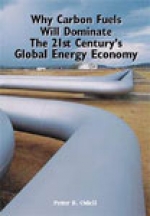Tab Article
Global energy demand has grown only slowly since the mid-1970s. This is predicated to continue, even without actions to limit/reduce CO2 emissions. Nevertheless, increasing energy use is required to eliminate energy poverty, not only for the 2 to 3 billion of the world's present population which suffer from the condition, but also for the net additional 3 billion inhabitants of planet earth by 2050. Sustainability for a more populous 21st century world depends on this development.
Carbon fuel use since 1970 has been much below expectations at that time. Consequently, proven reserves have expanded to an all-time high. These provide a secure base for supply growth of coal, oil and gas. Collectively their present 90% share of global energy use will decline only very slowly, viz. to 80% by mid-century and still over 55% by 2100.
Conventional expectations for a high growth rate in coal's use are unrealistic. At most, its contribution to fossil fuel supplies will be 30%. Thus hydrocarbons will remain dominant supplying over 50% of global energy use until post-2070. But their relative contributions will change dramatically. As gas supply grows more than five-fold over the century, it will contribute 57% of hydrocarbons supply (oil; 43%). Gas will overtake coal by 2010 and oil by 2040. Conventional and non-conventional gas reserves and resources will be adequate to maintain gas as a growth industry until post-2090 - even without a contribution from gas hydrates and geo-pressured gas.
Oil supply will likely be more demand than resources constrained - given the demand-side preference for gas for technical and commercial, as well as environmental, reasons. The remaining 2000x109 barrels of recoverable conventional oil resources will sustain over 50% of oil demand until almost 2060. Thereafter non-conventional oil will take the leading role. The latter's output will peak only in the penultimate decade of the century and by 2100 its resource-base will be little more than half-depleted. In spite of oil's relative decline as an energy source the industry will, nevertheless, be larger in 2100 than it was in 2000.
The historic and contemporary geo-political significance of the oil industry will, however, be undermined over the coming two decades. Thereafter, with its falling contribution to global energy supply and an increasingly dispersed geographical pattern of production, it will become "just another source of energy" in a competitive market.
Serious medium- to long-term upward pressures on oil and gas prices are unlikely. Higher finding/exploitation costs will be offset by technologically-derived savings. Modest real price increases from post-1986 levels (of 10 to 20% by 2020 and 20 to 30% by 2040) will subsequently be constrained by lower-cost renewable energy supplies.
Finally, what if oil and gas are NOT fossil fuels? As argued by the inorganic origin theorists of the Former Soviet Union - home to the world's largest hydrocarbons' industry. Enormous implications follow from oil and gas being renewable resources. All concerns for "scarcity" would be undermined and future oil and gas supplies at stable or falling costs could be guaranteed.


